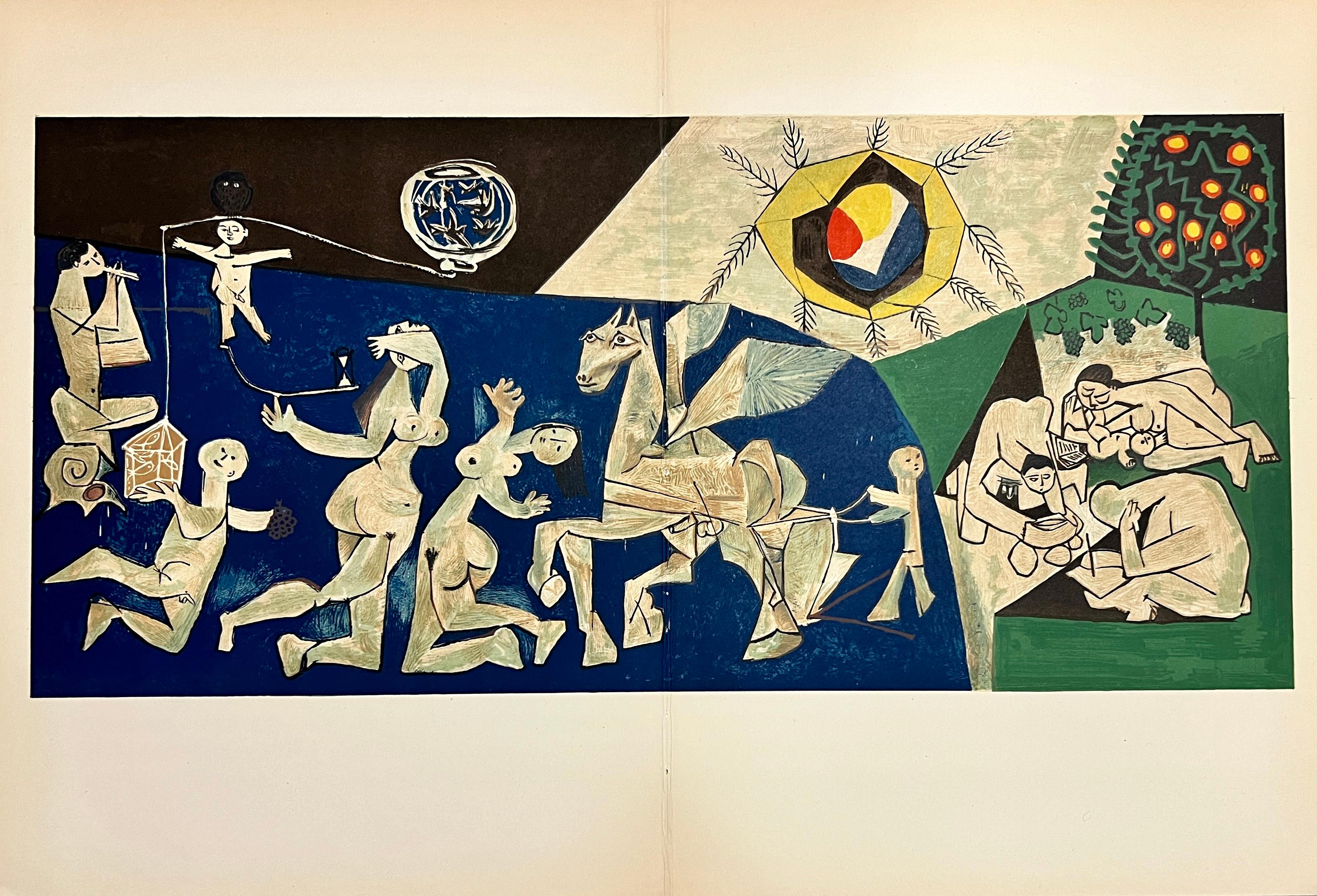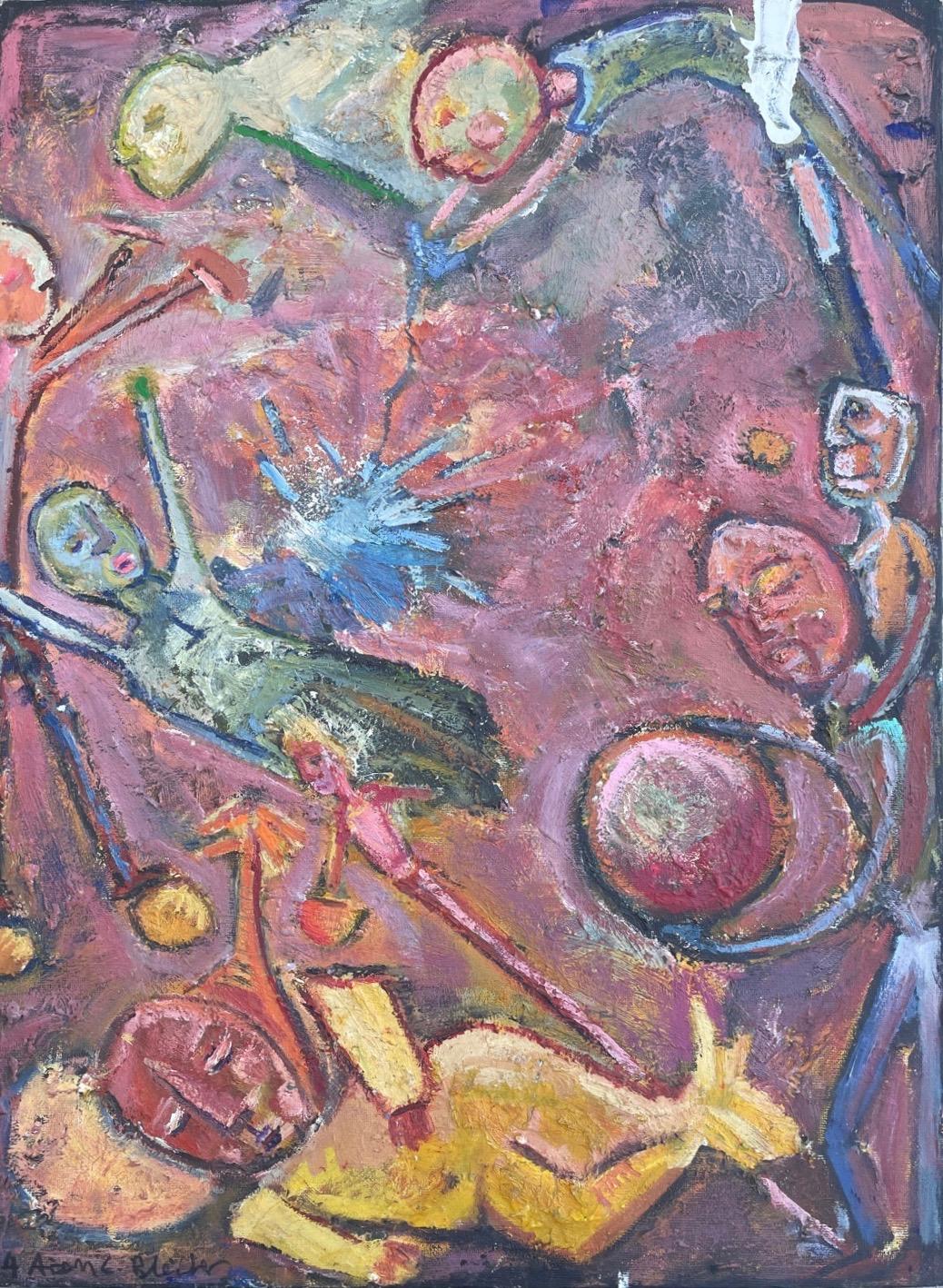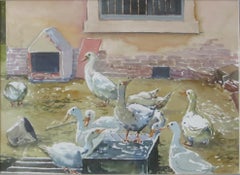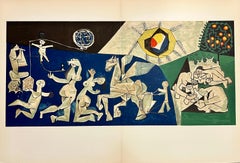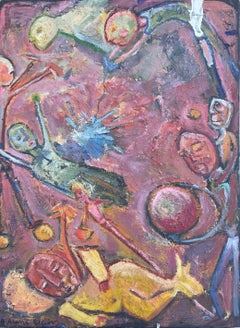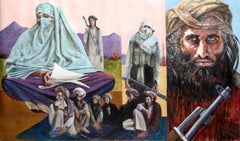Want more images or videos?
Request additional images or videos from the seller
1 of 9
Abel PannWar Scenec.1930
c.1930
$900
£680.10
€785.35
CA$1,257.61
A$1,395.43
CHF 730.96
MX$17,111.70
NOK 9,297.50
SEK 8,776.45
DKK 5,856.84
Shipping
Retrieving quote...The 1stDibs Promise:
Authenticity Guarantee,
Money-Back Guarantee,
24-Hour Cancellation
About the Item
This artwork "War Scene" c.1930 is a color lithograph on Wove paper by noted Latvian/Israeli artist Abel Pfeffermann Pan, 1883-1963. It is signed in the stone as issue and numbered 63/300 in pencil. The image size is 16 x 21 inches, sheet size is 18.25 x 24.5 inches. It is in excellent condition, has never been framed.
About the artist:
Abel Pann (1883-1963)
Born Abba Pfeffermann in Latvia or in Kreslawka, Vitebsk, Belarus, he was a European Jewish artist who spent most of his adult life in Jerusalem.
Pann studied the fundamentals of drawing for three months with the painter Yehuda Pen of Vitebsk, who also taught Marc Chagall.[1] In his youth, he traveled in Russia and Poland, earning a living mainly as an apprentice in sign workshops. In 1898 he went south to Odessa where he was accepted into the Academy of Fine Arts. In 1903, he was in Kishinev where he documented the Kishinev pogrom with drawings; an effort that is thought to have contributed to his self-definition as an artist who chronicles Jewish history. Still in 1903, he moved to Paris, where he rented rooms in La Ruche, a Parisian building (which still exists) where Modigliani, Chagall, Chaim Soutine and other Jewish artists also lived. Pann studied at the French Academy under William-Adolphe Bouguereau. He earned his living primarily by drawing pictures for the popular illustrated newspapers of the era.[1] In 1912, Boris Schatz, founder and director of the Bezalel Academy of Arts and Design visited Pann in Paris and invited him to come work in Jerusalem.
In 1913, after traveling in Southern Europe and Egypt, Pann arrived in Jerusalem where he had decided to settle for life. Pann went to see Schatz and it was decided that he would head the painting department at the Bezalel Academy for several months while Schatz embarked on an extensive overseasfund-raising trip. According to Haaretz art critic Smadar Sheffi, a work form this period with the simple title Jerusalem shows a cluster of buildings at sunset "with a sky in blazing orange." The painting is "more expressive and abstract that is typical of his work," and Sheffi speculates that "the encounter with the city" of Jerusalem was a "strong emotional experience" for the artist.
Pann returned to Europe to arrange his affairs before moving permanently to the British Mandate of Palestine, but was caught on the continent by World War I. Pann's wartime paintings would prove to be among "the most important" of his career. He made many posters to support the French war effort. He also made a series of fifty drawings showing the extreme suffering of Jewish communities caught in the fighting between Germany, Poland and Russia. Art critic Smadar Sheffi regards them as "the most important part of his oeuvre." These "shocking" drawings put modern viewers in mind of depictions of the Holocaust. Pann's drawings were intended as journalistic documentation of the fighting and were successfully exhibited in the United States during the War.[1] According to Pann's autobiography, the Russians, who were allied with the French, refused to allow a wartime exhibition of the drawings in France. According to the New York Times, the drawings were published in Paris during the war, but the government intervened ot block their distribution on the grounds that they "reflected damagingly upon an ally" (Russia).
Upon his post-war return to Jerusalem in 1920, Pann took up an teaching position at the Bezalel Academy and wrote that he was about to embark on his life-work, the painting and drawing of scenes from the Hebrew Bible. He returned briefly to Vienna where he met and married Esther Nussbaum and purchased a lithographic press, which the couple brought home to Jerusalem. Pann began work on a series of lithographs intended to be published in an enormous illustrated Bible, and although that series was never completed, he is widely admired for the series of pastels inspired by Bible stories that he began in the 1940s. The iconography of these works is linked to the 19th century orientalism. He was part of a movement of contemporary Jewish artists interested in Biblical scenes, including Ephraim Moses Lilien, and Ze'ev Raban. All three were influenced by Art Nouveau and by the Symbolist movement. This influence can be seen in "You shall not surely die," a colored lithograph in which the serpent is represented as a bare-chested woman. The lithograph is reminiscent of the style of Aubrey Beardsley.
In 1924, Pann resigned from his teaching position to devote himself full-time to lithography. The lithographs met with considerable success on international tours. Pann told the New York Times that he found most illustrated Bibles boring, accusing the many artists who had illustrated Bibles before him of tending "to produce an impression that the Bible itself is a tiresome volume." He said that he wished to present the Bible's characters as "possessing the passions of human beings... with their virtues and vices, loves and hatreds."
Especially in his pastels, Pann envisioned Rachel, Rebekah, and other Biblical women as child-brides and imagined the teen-aged Jewish girls from Yemen whom he used as models along with young Bedouin girls, regarding both Yemenites and Bedouins as authentic oriental types.[2] He posed them in elaborate traditional wedding and festival clothing and jewelry. In the twenties, the period when Pann was painting them, Yemenite and Bedouin girls did marry at the age of puberty. He often captured not only their youth and beauty, but the anxiety of a young girl about to marry a man she might hardly know. Other pastels capture the elderly matriarch Sarah looking "absolutely alive" and the care-worn facts of Jerusalem's Yemenite Jewish laborers, posed as Biblical patriarchs.[2]
Pann's work reveals an intimate familiarity with the work of Rembrandt, James Tissot, and other European painters of biblical scenes. Among his most original approaches was a pastel of Potiphar's wife. This familiar theme had for hundreds of years and in the hands of innumerable artists conventionally depicted a mature beauty seducing an innocent youth, Joseph. According to art critic Meir Ronnen, Pann's interpretation, a late period pastel dating from the 1950s, depicts Potiphar's wife as a spoilt child, an extremely young and very bored girl who is "possibly just one of the lesser playthings of a gubernatorial harem." She turns her bored gaze on the young Israelite. Ronen considers her to be "the most brilliant of all Pann's creations."
Pann's youngest son was killed in the Israeli War of Independence. After that loss, he turned to painting scenes of the Holocaust. He died in Jerusalem in 1963.
Selected Exhibitions:
Abel Pann Paints the Bible, The Israel Museum, Jerusalem. Curator: Yigal Zalmona. (2003)[1]
"Abel Pann - The painter of The Bible, Catalogue by Shlomit Steinberg and Felix Salten, The Jewish Museum, Vienn (2001).[6]
Abel Pann, Mayanot Gallery, Jerusalem. (1987)[7]
Paintings, Drawings, and Lithograph by Abel Pann," Art Institute of Chicago, (1920) [8]
Books and articles:
Shlomit Steinberg (1991) The Image of the Biblical Woman as Femme Fatale in Abel Pann Works (Jerusalem): MA Thesis, The Hebrew University
Yigal Zalmona (2003), The art of Abel Pann: from Montparnasse to the Bible, Jerusalem: The Israeli Museum.
References:
1. "Painter of the Jewish fate; The Abel Pann exhibition at the Israel Museum is not called a retrospective, but in the introduction to the catalogue the director of the Israel Museum, James Snyder, defines it as "the first comprehensive museum presentation of his work," Smadar Sheffi, 17.11.03, Haaretz.
2. "Pann's People of the Book." Meir Ronnen, Nov. 14, 2003, Jerusalem Bost.
3. Abel Pann At The Mayanot Gallery, June 18, Richard McBee, Jewish Press.
4. OLD TESTAMENT PICTURED ANEW; Abel Pann, an Artist of Jerusalem, Has Worked Eight Years at His Difficult Task of Illustrating the Bible and It Is Still Far From Complete OLD TESTAMENT IS PICTURED ANEW," Louis Rich, March 21, 1926, New York Times Sunday Magazine.
5. "Jerusalem Artist Paints New Bible Series; Abel Pann Finds Usual Pictures Dull," Dec. 7, 1924, New York Times.
6. Mayanot Gallery
7. Mayanot Gallery
8. Exhibitions, Bulletin of the Art Institute of Chicago (1907-1951), Vol. 14, No. 1 (Jan., 1920), p.6.
- Creator:Abel Pann (1883 - 1963, Russian)
- Creation Year:c.1930
- Dimensions:Height: 18.25 in (46.36 cm)Width: 24.5 in (62.23 cm)Depth: 0.01 in (0.26 mm)
- Medium:
- Movement & Style:
- Period:
- Condition:
- Gallery Location:San Francisco, CA
- Reference Number:Seller: pann/war/011stDibs: LU66637824482
Abel Pann
“Over many years, Abel Pann (1883-1963) was regarded as the foremost Land Of Israel Painter. This view was shared by the Jewish community throughout the world and by the general public in pre-State Israel where reproductions of his works were hung in almost every home”. This is how Yigal Zalmone, Chief Art Curator of the Israel Museum, describes Abel Pann. Abel Pann was born in 1883 in the town of Kreslawka in the Vitebsk region of White Russia. His father Nahum was a rabbi and head of a yeshiva, a religious academy. Pann received a Jewish elementary school education until he was twelve. He studied the fundamentals of drawing for three months with the painter Yehuda Pen of Vitebsk, who also taught Marc Chagall and Ossip Zadkine. When he was twelve he traveled between Russia and Poland, earning money as an apprentice in sign workshops. In 1898 he went south to Odessa, where he was accepted by the Academy of Fine Arts. In 1903 Pann moved to Paris, where his work included depictions of Jewish daily life, Parisian genre paintings, as well as sketches and caricatures that were humorous and psychological criticisms regarding society. His empathy for the poor and wretched became well known. In 1912, the director of the Bezalel School of Art and Crafts in Jerusalem asked Abel Pann to teach at the school which he accepted a year later. During the first year of World War I, Pann was restricted to leave Europe after he returned to recover belongings to take back to Jerusalem. During the first years of the war, he concentrated on popular, nationalist posters and illustrations, including depictions of the cruelty of the German enemy. In 1920 he returned to Jerusalem and resumed teaching at the Bezalel School, and formed the Palestine Art Publishing Company with which he used to print his albums of Bible illustrations. Abel Pann devoted much of his energy to these illustrations. An interesting approach that Pann used in these illustrations was to depict the Biblical subjects using contemporary clothing and imagery. Using contemporary Middle Eastern characters in Oriental dress within local settings fulfilled the Zionist dream that the Jewish people were going to return to their homeland and renew their days of old.
About the Seller
5.0
Platinum Seller
Premium sellers with a 4.7+ rating and 24-hour response times
Established in 1999
1stDibs seller since 2017
808 sales on 1stDibs
Typical response time: 1 hour
- ShippingRetrieving quote...Shipping from: San Francisco, CA
- Return Policy
Authenticity Guarantee
In the unlikely event there’s an issue with an item’s authenticity, contact us within 1 year for a full refund. DetailsMoney-Back Guarantee
If your item is not as described, is damaged in transit, or does not arrive, contact us within 7 days for a full refund. Details24-Hour Cancellation
You have a 24-hour grace period in which to reconsider your purchase, with no questions asked.Vetted Professional Sellers
Our world-class sellers must adhere to strict standards for service and quality, maintaining the integrity of our listings.Price-Match Guarantee
If you find that a seller listed the same item for a lower price elsewhere, we’ll match it.Trusted Global Delivery
Our best-in-class carrier network provides specialized shipping options worldwide, including custom delivery.More From This Seller
View AllUntitled
By Michael Bergt
Located in San Francisco, CA
Artist: Michael Bergt – American (1956- )
Title: Untitled
Year: unknown, circa 1985
Medium: Watercolor
Sight size: 10.5 x 14.5 inches.
Framed size: 17.5...
Category
1980s Realist Animal Paintings
Materials
Paper, Watercolor
Market Scene
Located in San Francisco, CA
This artwork "Market Scene" 1968 is an oil painting on canvas by noted Haitian artist Petion Savain, 1906-1973. It is signed and dated at the lower right...
Category
Mid-20th Century Modern Figurative Paintings
Materials
Oil
J.P
By Charles Bragg
Located in San Francisco, CA
This artwork titled "J.B" c.1970 is a lithograph on paper by noted American artist Charles Bragg, 1931-2017. It is signed and titled in the plate as issue. The image (Stone mark) size is 5 x 8 inches, framed is 15.35 x 12 inches. It is custom framed in a wooden brown frame, with off white matting. It is in very good condition, paper is slightly toned by age.
About the artist.
Charles Bragg was born in St. Louis, Missouri to two Vaudeville performing parents that he traveled with throughout his childhood. He attended New York’s High School of Music and Art in Harlem and ran away with his sweetheart when he turned 18.
He studied at the Art Students League in New York and later resided in Los Angeles. Before he decided to truly pursue painting, Bragg was a cab driver, a truck driver, a stand-up comedian, and a factory worker. When he arrived in California, he began painting for the wealthy and even gave lessons. It was during this time that he began to develop satirical feelings for the upper-class he was painting.
Considered the foremost social satire artist in America, Charles Bragg is highly acclaimed for his cryptic and humorous portraits. Bragg is a spiritual descendent of Bosch, Brueghel and Daumier
His work is found in the collections of at least 20 international museums, including thePushkin Museum, Moscow, USSR - Galleria d' Arte, Moderna de Milano Stedelijk Museum, Amsterdam, Holland - Dayton Art Museum, Ohio - DowneyMuseum of Art, California - Long Beach Museum of Art, California - Wichita State University Collection - Roswell Museum Collection, New Mexico - Canton Art Institute, Ohio - Loch Haven Art Center, Orlando Florida - University of Wyoming Museum of Art - The Albrecht Museum of Art, St Joseph, Mo - St Lawrence University, Canton, NY - Gibbes Art Center, Charleston, SC - Kalamazoo Institute of Arts, Michigan ¬University of Judaism, Los Angeles, Ca - Joslyn Art Museum, Omaha, Nebraska - Tyler Museum of Art, Tyler, Texas - Joseph Hirshhorn Collection, National Gallery of Design...
Category
Late 20th Century Other Art Style Figurative Prints
Materials
Lithograph
Too Far II
Located in San Francisco, CA
This artwork titled "Too Far II" 2004 is an original mixed media (color monotype and pencil drawing) by noted Swiss artist Francois Burland b.1958. It is hand signed, dated, numbered 1/1 and dedicated in pencil by the artist. The subject size is 7.75 x 10.5, including the pencil drawing is 10.75 x 13 inches, sheet size is 13 x 19.75 inches, framed size is 21 x 28 inches. Custom framed in a wooden black frame, with white matting. It is in excellent condition.
About the artist:
François Burland (1958) was born in Lausanne (Switzerland). He began drawing in self-taught fashion at the end of his adolescence. He undertook a first trip to Egypt's Sinai Peninsula at the age of twenty. A few years later, he encountered the Tuaregs in the Sahara Desert. Enthused by their nomadic lifestyle, he began returning to the region regularly over some thirty years. During his long stays with the Tuaregs, he shared their daily life, including their dromedaries and witchcraft, but also their 4x4s, mobiles and kalachnikovs.
This creator has produced an abundant and varied oeuvre. Depending on each series and on his inspiration of the day, he avails himself of a number of techniques and materials. For his drawings, he prefers to use wrapping paper as a support: he applies pastels, colored pencil and white chalk to very large surfaces. His creations bring to mind shamanic art...
Category
21st Century and Contemporary Modern Mixed Media
Materials
Mixed Media, Monotype
Pessach
By David Sharir
Located in San Francisco, CA
This artwork titled "Pessach" from the suite "The Seven Festivals" 1981, is an original colors serigraph on Arches paper by noted Israeli artist David Sharir,b. 1938. It is hand sign...
Category
Late 20th Century Modern Figurative Prints
Materials
Screen
Pastourelle
Located in San Francisco, CA
This artwork titled "Pastourelle" c.1990 is a color etching and aquatint by French artist Charlotte Reine, b.1956. It is hand signed, titled and number...
Category
Late 20th Century Modern Figurative Prints
Materials
Etching, Aquatint
You May Also Like
La Guerre et la Paix
By Pablo Picasso
Located in OPOLE, PL
Pablo Picasso (1881-1973) - La Guerre et la Paix
Lithograph from 1954.
Dimensions of work: 53 x 35.5 cm.
Publisher: Éditions Cercle d'Art, Paris.
Each copy of this Lithograph was...
Category
1950s Modern Figurative Prints
Materials
Lithograph
Confliction
By Airom
Located in Santa Monica, CA
Oil and acrylic on canvas.
Category
Early 2000s Contemporary Figurative Paintings
Materials
Canvas, Oil, Acrylic
$650 Sale Price
35% Off
New Holy Wars
By John Hardy (Artist)
Located in Long Island City, NY
New Holy Wars
John Hardy, American (1923–2014)
Oil on Canvas
Image Size: 36 x 59 inches
Size: 40.75 x 64 in. (103.51 x 162.56 cm)
Category
Late 20th Century Contemporary Figurative Paintings
Materials
Oil
War, Painting, Acrylic on Canvas
By Amy Bernays
Located in Yardley, PA
What is he thinking, what are they thinking? How do you make sense of the world through arms? How foreign this minds is that was made from me? :: Painting :: Fine Art :: This piece...
Category
21st Century and Contemporary Paintings
Materials
Acrylic
(Wounded Soldiers)
Located in New York, NY
While this is a World War II drawing, the barbed wire recalls the tranches of the First World War. A menacing tank at the upper left dominates the scene.
There is a black border and...
Category
Mid-20th Century American Modern Figurative Drawings and Watercolors
Materials
Gouache
$1,200
Triage
By Don Schol
Located in Denton, TX
Edition of 8
Signed, titled and numbered.
From the series: Vietnam Remembrances
After receiving his MFA at the University of Texas in 1966, Don Schol was drafted into the Army and ...
Category
21st Century and Contemporary Contemporary Figurative Prints
Materials
Woodcut
$1,500
More Ways To Browse
World War 1 Jewelry
Antique Art Nouveau Picture Frames
Art Nouveau Clothing
Antique French Bible
Antique German Bible
Antique Bible Book
Wedding Chest 19th Century
Antique Wedding Chest
Antique Wedding Chests
Antique Illustrated Bible
4 X 6 Antique Picture Frames
Antique Bedouin
Snyders Antique
Antique Yemen
Antique Hebrew Books
Community Playthings Used
Iwo Jima
Jacques Marie Gaston Onfroy De Breville
